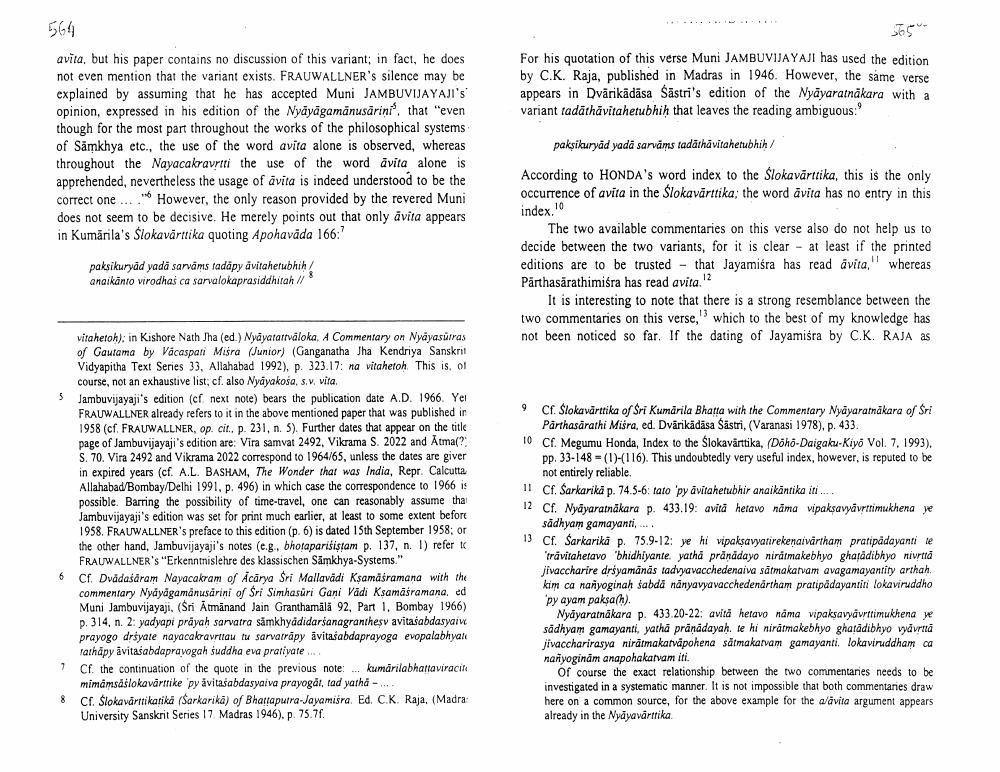Book Title: Avita And Avita Author(s): Eli Franco Publisher: Eli Franco View full book textPage 2
________________ 564 - اس سحر For his quotation of this verse Muni JAMBUVIJAYAJI has used the edition by C.K. Raja, published in Madras in 1946. However, the same verse appears in Dvärikādāsa Sastri's edition of the Nyāyaratnākara with a variant tadăthāvitahetubhiḥ that leaves the reading ambiguous: avita, but his paper contains no discussion of this variant; in fact, he does not even mention that the variant exists. FRAUWALLNER's silence may be explained by assuming that he has accepted Muni JAMBUVIJAYAJI'S opinion, expressed in his edition of the Nyayagamanusarini". that "even though for the most part throughout the works of the philosophical systems of Samkhya etc., the use of the word avita alone is observed, whereas throughout the Nayacakravrtti the use of the word avita alone is apprehended, nevertheless the usage of avita is indeed understood to be the correct one ...*However, the only reason provided by the revered Muni does not seem to be decisive. He merely points out that only avita appears in Kumārila's Slokavārtika quoting Apohavada 166.' paksikuryad yadā sarvams tadäthävitahetubhih / According to HONDA's word index to the Slokavārttika, this is the only occurrence of avita in the Slokavārttika: the word avita has no entry in this index. paksikuryad yadā sarvams radāpy avitaherubhih! anaikanto virodhas ca sarvalokaprasiddhirah // The two available commentaries on this verse also do not help us to decide between the two variants, for it is clear - at least if the printed editions are to be trusted - that Jayamiśra has read avita," whereas Parthasārathimiśra has read avita." It is interesting to note that there is a strong resemblance between the two commentaries on this verse, which to the best of my knowledge has not been noticed so far. If the dating of Jayamisra by C.K. RAJA as vitahetoh), in Kishore Nath Jha (ed.) Nyāyatartvaloka. A Commentary on Nyāyasútras of Gautama by Vacaspati Misra (Junior) (Ganganatha Jha Kendriya Sanskrit Vidyapitha Text Series 33, Allahabad 1992), p. 323.17: na vitahetoh This is, ol course, not an exhaustive list, cf. also Nyayakosa, s.v, vita Jambuvijayaji's edition (cf next note) bears the publication date A.D. 1966. Yel FRAUWALLNER already refers to it in the above mentioned paper that was published in 1958 (cf. FRAUWALLNER, op. cit., p. 231, n. 5). Further dates that appear on the title page of Jambuvijayaji's edition are: Vira samvat 2492, Vikrama S. 2022 and Atmal? S. 70. Vira 2492 and Vikrama 2022 correspond to 1964/65, unless the dates are giver in expired years (cf. A.L. BASHAM, The Wonder that was India, Repr. Calcutta Allahabad/Bombay/Delhi 1991, p. 496) in which case the correspondence to 1966 is possible. Barring the possibility of time-travel, one can reasonably assume that Jambuvijayaji's edition was set for print much earlier, at least to some extent before 1958. FRAUWALLNER's preface to this edition (p. 6) is dated 15th September 1958; or the other hand, Jambuvijayaji's notes (eg, bhotaparisistam p. 137, n. 1) refer k FRAUWALLNER'S "Erkenntnislehre des klassischen Samkhya-Systems." Cf. Dvadašaram Nayacakram of Acārya Sri Mallavadi kşamasramana with the commentary Nyayagamánusarini of Sri Simhasuri Gani Vadi Ksamásramana, ed Muni Jambuvijayaji. (Sri Atmānand Jain Granthamälä 92, Part 1, Bombay 1966) p. 314, n. 2. yadyapi prāyaḥ sarvatra samkhyadidarsanagranthes avitasabdasyai prayogo dršpate nayacakravrtau tu sarvatrāpy avitasabdaprayoga evopalabhyak fathāpy avitasabdapravogah suddha eva prativate Cf. the continuation of the quote in the previous note: ... kumarilabhattaviraci mimamsašlokavārstike py avitasabdasyaiva prayogál, tad yarha-.... Cf. Slokavarttikarika (Sarkarika) of Bhattaputra-Jayamisra Ed. C.K. Raja. (Madra: University Sanskrit Series 17 Madras 1946). p. 75.7. 9 Cr. Slokavårttika of Sri Kumärila Bhatta with the Commentary Nyayaratnākara of Sri Parthasarathi Mišra, ed. Dvārikādāsa Sastri, (Varanasi 1978), p. 433. 10 Cf. Megumu Honda, Index to the Slokavårttika, (Döho-Daigaku-Kiyo Vol. 7. 1993). pp. 33-148 = (1)-(116). This undoubtedly very useful index, however, is reputed to be not entirely reliable. Il Cf. Sarkarika p. 74.5-6: tato 'py avitahetubhir anaikāntika iti.... 12 Cf. Nyāyaratnākara p. 433.19: avitā hetavo nāma vipaksavyāvrtkimukhena ye sādhyam gamayanti..... 13 Cf. Sarkariká p. 75.9-12: ye hi vipaksavyatirekenalvärtham pratipadayanti le 'trăvitahetavo 'bhidhiyante. yathā prānādayo nirarmakebhyo gharadibhyo nività jivaccharire drsyamānās tadvyavacchedenaiva sārmakatvam avagamayantity arthah. kim ca nanyoginah sabda nanyavyavacchedenártham pratipadayantini lokaviruddho py ayam paksa(h). Nyayaratnākara p. 433.20-22: avita hetavo nama vipaksavyavrfrimukhena ve sådhyam gamayanti, yathā prānādayah. te hi niratmakebhyo gharadibhyo vyavirta jivaccharirasya nirārmakatvāpohena satmakarvam gamayanti. lokaviruddham ca nanyoginām anapohakatvam iti. Of course the exact relationship between the two commentaries needs to be investigated in a systematic manner. It is not impossible that both commentaries draw here on a common source, for the above example for the alavita argument appears already in the Nyayavārtika. 8Page Navigation
1 2 3 4 5 6 7 8
